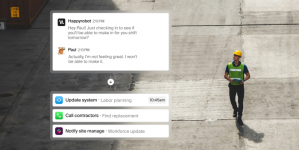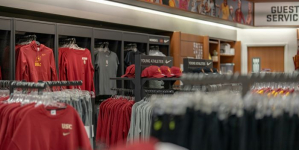-
AI startup Onton raises $7.5M to reinvent the way the world discovers and decides what to buy - November 26, 2025
-
Forklift Market Positions for Recovery as Confidence Expected to Build from 2026 - November 26, 2025
-
PROCare achieves 300% order capacity increase and 99% picking accuracy with Forterro’s ERP solution, Orderwise - November 26, 2025
-
DHL boosts operational efficiency and customer communications with HappyRobot’s AI Agents - November 25, 2025
-
STENA LINE TEAMS UP WITH CAMERA TELEMATICS TO DRIVE SAFETY IMPROVEMENTS AT IRISH SEA PORTS - November 25, 2025
-
Another design award for Toyota’s lithium-ion Traigo_i counterbalanced forklift - November 21, 2025
-
Stuut Technologies Raises $29.5 Million Series A Led by Andreessen Horowitz to Automate Accounts Receivable Work - November 20, 2025
-
INCREASED DIGITAL INVESTMENT REQUIRED TO KEEP PACE WITH 2026 CUSTOMS CHANGES - November 19, 2025
-
FULFILMENT SOLUTIONS FOR SPORTS MERCHANDISE: KEEPING OUR EYE ON THE GAME - November 19, 2025
-
COMPLEX, COSTLY & CONFUSING – THE END OF DE MINIMIS - November 19, 2025
How Agile A Supply Chain Can You Afford?
By Sid Holian
One of the greatest challenges facing retail businesses today is how to keep the customer proposition attractive yet affordable.
Many retailers are drawn into a potentially damaging position where investments into complex logistics systems designed to compete through offering later and later cut-offs, diverse delivery options such as to store, locker or home, and even same-day delivery, are simply creating fixed costs that could prove damaging if circumstances change. At what point does extra capability cease to be a competitive advantage and become an unnecessary burden or an unacceptable risk?
In many instances return on investment in warehouse technology is no longer driven by cost-per-order but by an overriding desire to fulfil consumer demand by whatever means possible. Such an approach can rapidly place the business at the bleeding edge of ‘competitive advantage’.
There is a balance that needs to be carefully considered and only when all the constraints, ‘what ifs?’ and risks have been taken into account can the optimum solution be reached. There are wider questions too for the sector as to who should pay for service enhancements and whether greater collaboration on delivery is the only way forward.
A significant factor in this equation is the willingness of the consumer to pay extra for faster delivery. Results from PWC’s Global Consumer Insights Survey 2018 reveal that over 40% of online shoppers would pay an extra charge for same day delivery and a quarter of respondents said they would pay for getting their packages within a one or two-hour window of their choosing. Some 23% of respondents said they were willing to pay a charge for next-day delivery.
However, a big question is just how much is the consumer willing to pay for these services? Other surveys suggest that free delivery is a significant factor when consumers make an online purchase. Research conducted by Advantec in 2017 indicates that 49% of respondents rated free delivery as the most important consideration when buying online – significantly above fast-delivery at 14% and same-day delivery at 17%. So, to what extent could free delivery boost sales? And does the investment and risk involved fit with the business strategy?
Along with a huge rise in complexity around delivery options and fulfilment processes comes greater uncertainty and risk – factors that demand increased flexibility from a business to respond quickly to changing circumstances, such as new competitive offers or services, and radical shifts in demand.
To achieve this flexibility, and to survive and thrive, modern retail businesses must now be, above all else, agile. And this agility must be built in to the very fabric of the organisation, from the way orders are managed, inventory planned and labour resources allocated, to the design of order picking processes, warehouse layout and despatch operations.
Agility is all about speed of reaction and the ability to change and respond quickly and effortlessly. For most retailers that not only means a physical change but, critically, a change in mindset too. In order to be more agile it is necessary to look carefully at the long-term business strategy, with great attention being paid to risk analysis around ‘what if?’ scenarios – something that needs to be reviewed on a regular basis, perhaps quarterly.
But of course, responsiveness and agility come at a cost and determining and understanding those costs is essential to the protection of margin and the competitive positioning of the business.
These critical factors, along with many others necessary for understanding the business case for investment, are explored in a new, free downloadable eBook “Why an agile and responsive supply chain is a must-have”. Amongst the contributors is Tim Allinson, Global Supply Chain Director of fashion brand Jack Wills, who sees the advantages to using the store network to fulfil online orders too. He says: “We have a hub store model so when we change season, if we cannot fulfil from the distribution centre, we can fulfil from the store. That’s a definition of agility for me.”
To gain further insights and a greater understanding of the balanced business case for a more agile and responsive supply chain, download the free eBook here: https://www.bis-henderson.com/ebook-1-launch/
Sid Holian is Managing Director at Bis Henderson Consulting: www.bis-hendersonconsulting.com

































